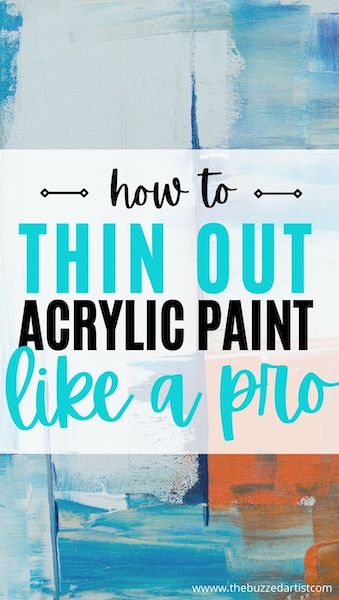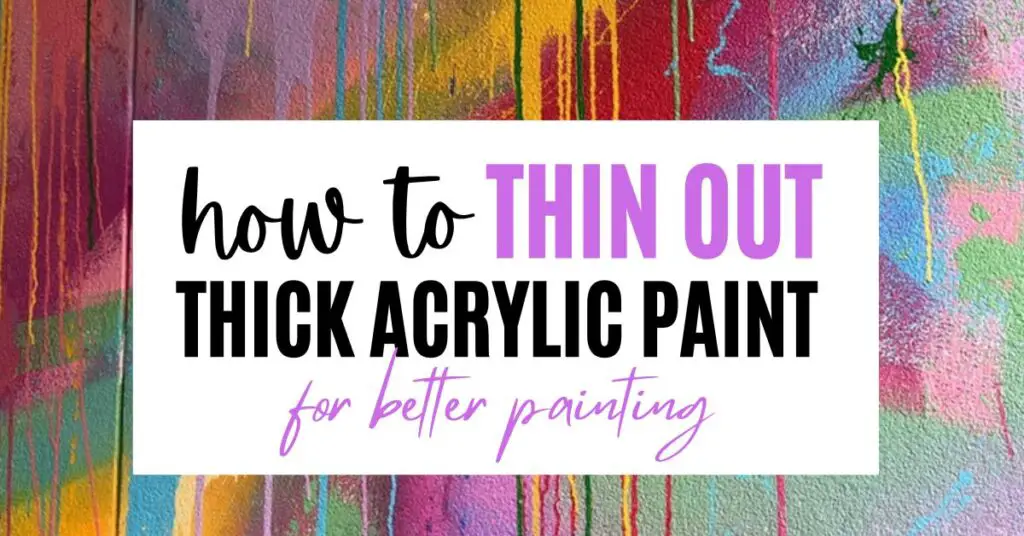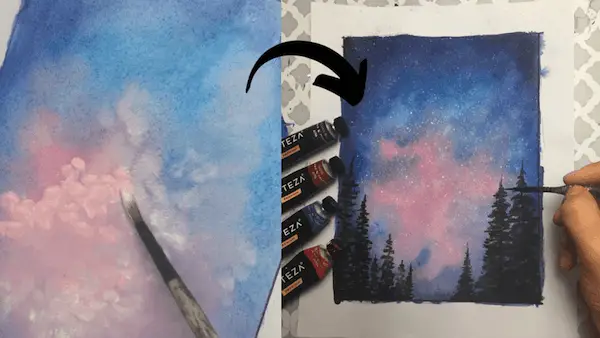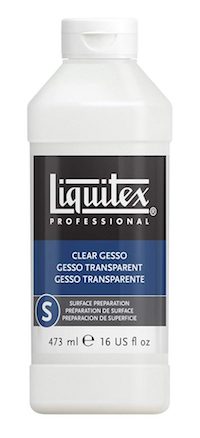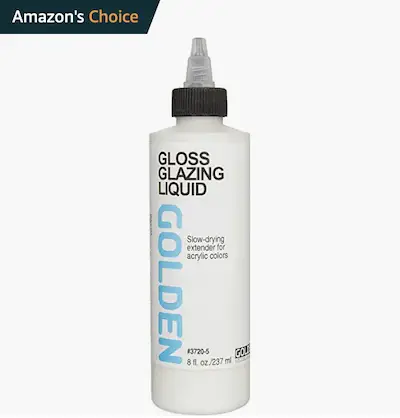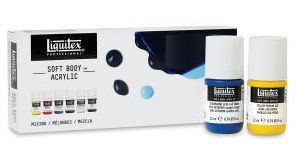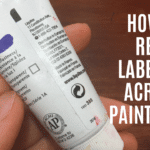Easy methods for thinning out thick acrylic paint to add more versatility for your paintings
Sometimes, using thicker paint as-is could easily overtake your entire painting, making it harder for you to create those sexy smooth blends, finer details, or crisp lines. When this happens, there are lots of easy methods to thin out your thick paint and get it to do what you want on the canvas.
The best way to thin out thick acrylic paint to the right consistency are as follows:
- Adding water to the paint
- Diluting with an acrylic medium
- Buying paint with your desired consistency
In a HURRY? ⤵
✅ This is our personal favorite way to thin out thick acrylic paint for best results without completely ruining it
OK, so thinning out acrylic paint is a great idea, but it presents a myriad of additional questions:
- How much should I add?
- How much is too much?
- What types of acrylic mediums can I use without ruining the paint itself?
In this post, we’ll dive into the best acrylic paint thinners, the different thinning agents out there, all of which you can find at your local hardware store or art supply stores.
Pin it for later! ⤵
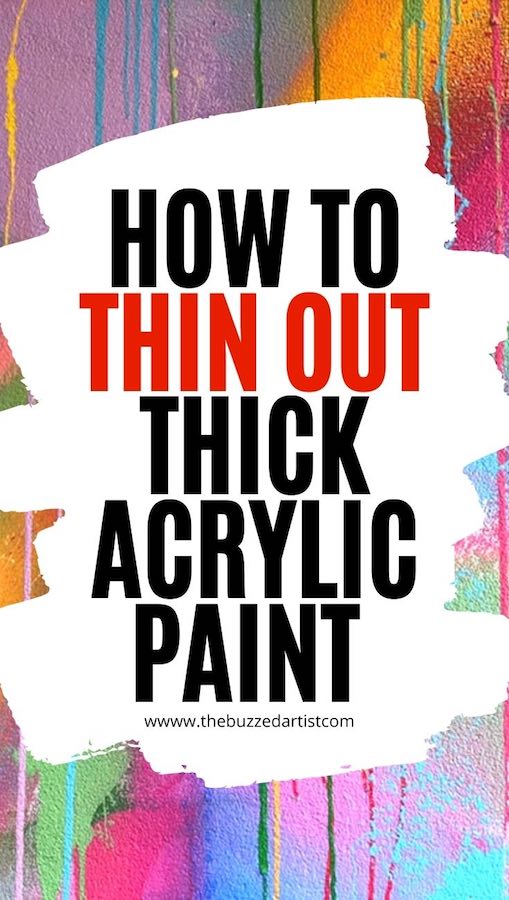
Disclaimer: some links below are affiliate links, which means I will earn a small commission if you make a purchase using one of those links at no extra cost to you. I always recommend products that have been helpful to me and my readers, and I hope you’ll love them as much as I do!
METHOD #1: Adding Water to Thin Out Acrylic Paint
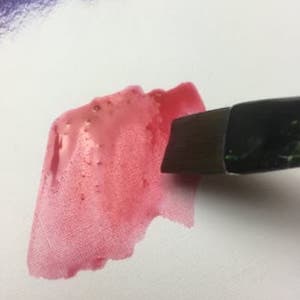
If this is your first time trying to thin out paint, one of the easiest ways to do that is by adding water to it.
However there are few things to keep in mind when diluting paint with water.
See, acrylic paint is actually comprised of acrylic polymer emulsion, containing binders that hold the pigment and structure all together.
So, adding water actually breaks down the acrylic binder in paint, thinning it to resemble that of watercolors, allowing it to sink into the surface of the support and dry with a matte finish.
Better yet, distilled water is an even better paint thinner than water, since it contains less impurities and allows for better flow, especially for airbrush paint.
Adding too much water however can cause the binders to break down so much that the paint won’t be able to adhere together or provide good coverage.
Plus, after your paint dries, there is a great likelihood for the paint to chip or flake off the canvas. Blegh, that would suck!
So, if that is an effect you want to avoid, consider adding 25-30 percent water to your paint to dilute it. Honestly, a little bit can go a long way.
To take this even further, you can use super diluted acrylics to create transparent paints that mimic washes and watercolors!
I have created watercolor effects just by using acrylic paints, (and even made a whole class about it) diluting it with a lot of water (about 60%) and creating washes and layers of color. So really, it’s up to you what effect you want to go for at the end of the day.
If you want to try creating a whole gorgeous scene with acrylic watercolor effects, you can try my class Watercolor Effects with Acrylics free for 1 month on Skillshare.
METHOD #2: Using Acrylic mediums to Make Thinner Paint
Another easy way to thin out acrylic paint for better results is to mix in various acrylic mediums with your paint. A big advantage of using these mediums is it maintains the integrity of the acrylic binders, therefore you’ll still get coverage no matter how much medium you add.
The paint will simply thin out and become more transparent the more medium you add. It also allows the paint to sit on the surface of the canvas or support, keeping it’s glossy finish.
Now, what kinds of acrylic mediums are good for thinning out acrylic paint? Some include the following:
Related Acrylic Paint Technique Articles:
- How to Thicken up Acrylic Paint for More Texture
- How to Keep Acrylic Paint Wet for Longer
- How to Repair and Clean Paint Brushes
Acrylic Medium #1: Gesso
Gesso, like this one here, is a white (or clear) paint mixture consisting of a binder mixed with chalk, gypsum, pigment, or any combination of these. Gesso is usually used for priming surfaces for painting – in fact, most canvases are already pre-coated with gesso for easier paint application.
✅ This Liquitex gesso is fantastic for prepping and priming surfaces for painting and lots of people love it for thinning acrylics.
Read More: Is Gesso Totally Necessary when Painting?
There are two approaches to using gesso to thin out your paint.
The first approach is to prime your canvas or final support with gesso so that whatever paint you add on top will not absorb into the support itself. This is a good idea when used with thin paint, especially if you want to create a more wash-like or stain effect with your thinned out paint.
The second approach would be to mix the gesso and acrylic paint together with a palette knife to thin it out to your desired consistency. Since you probably want to keep the same color/tone of your desired paint, I would recommend choosing clear gesso, like this one, to do your thin bidding.
Read more: Use Gesso to Re-Use Any Canvas for New Paintings
Acrylic Medium #2: Thinning/anti-congealing agents
Acrylic paint thinners that provide anti-congealing capabilities can be a great option to thin out your acrylic paint.
Two paint thinners that come to mind include:
- Golden Open Thinner (the art company Golden has created an acrylic thinner that can not only thin your paint, but also slow down the drying time of your acrylics)
- US Art Supply AirBrush Thinner (even if you don’t work with airbrushes, airbrush thinners are really great at thinning acrylic paint without compromising the paint coverage or color. You’ll have to add a bit at a time into your acrylic paint to get your desired texture)
Acrylic Medium #3: Acrylic glazing liquids
Acrylic glazing liquids can serve as a way to thin out acrylic paint and are usually milky white in appearance and have a slight runny quality to them.
Some glazing liquids have slow-drying paint extenders pre-mixed in that can be used to keep your acrylics from drying too quickly and can dilute your paint strokes without compromising canvas coverage (which water has been known to do with acrylics). No need to follow an exact ratio.
✅ Golden glazing liquid is our favorite way to thin out acrylic paint AND keeps them wet for much longer. Plus it’s available in gloss and satin finish.
When mixing this in with your paint, you can continually add glazing liquid to further dilute your coverage – making it really awesome for subtle blending edges.
Read more: Easy Ways to Keep Your Acrylics Wet for Longer
Acrylic Medium #4: Flow improvers
Flow improvers, like the type that is used for acrylic pouring, help break down paint viscosity so it can better flow and spread on canvas, without compromising color strength or saturation. I have commonly seen these types of thinners for fluid pour artworks which need a higher flow rate, but these can also be used for other painting projects as well.
Some great flow improvers include the following:
- Winsor & Newton Artists’ Acrylic Flow Improver (increases flow and open time for acrylics)
- Liquitex Professional Flow Aid (increases flow and open time for acrylics)
- Monte Marte Premium Acrylic Flow Medium
How much acrylic medium can I add?
That would depend on the acrylic medium you are using and their specific instructions on the packaging; but as a rule of thumb, consider adding medium a little bit at a time to your acrylic paint and observe the resulting mix and transparency.
Because you’re not dealing with water (and the resulting breakdown of binders), you can add acrylic medium without careful observation of specific ratios or compromise of paint coverage capabilities.

METHOD #3: Buy the right paint
If you want to avoid using additional mediums or want to simplify your paint thinness methods, buying paint with your desired viscosity is a great option.
Read more: How to choose the right kind of acrylic paint
Why does paint viscosity matter for thinning paint?
If you’re looking to thin your paint without compromising it’s integrity, choosing paints that are lower in viscosity can be a big time-saver and a better use of your efforts. Plus, you don’t have to do any additional mixing or medium additions.
For example, if you typically use heavy body paints but you struggle thinning them out, try working with either soft-body or liquid acrylics.
👉 Soft body acrylic paints are usually a good-middle ground paint for lots of projects and is one I prefer because I can add a small amount of water to get amazing thinned out paint with great flow.
✅ Liquitex makes an awesome set of professional soft body acrylics that are cost effective (and lots of fun to use). And if you can find this set for under $50, it’s a great buy!
Fluid Acrylics
Fluid or Liquid acrylics are a free-flowing, extremely diluted paint with a milk-like consistency, a very common one being acrylic ink, like these ones from Magic Color.
Fluid acrylics are ideal for paintbrushes, airbrush, paint pouring and frescoes (to name a few).
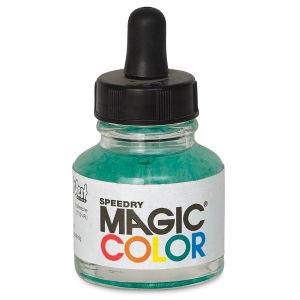
MORE Frequently Asked Paint THINNING Questions

Can I thin acrylics with household items?
Yes, you can. There are a fair amount of artists that have resorted to their kitchen or pantries to help thin out their acrylics, much to their success. Some common household items you can use include the following:
Can I use Mineral Spirits as an Acrylic Paint Thinner?
While mineral spirits is commonly used for thinning oil paint, it won’t really work well with acrylic paint, and this has to do with the composition. Acrylics are water-based while mineral spirits are solvent-based, which means putting those two things together will not mix or interact very well. Best to avoid.
Can you use alcohol or acetone to thin acrylic paint?
Some artists swear by using isopropyl (aka rubbing) alcohol for thinning their paints, and this is relatively true but with a caveat. High concentrations of rubbing alcohol (90%+) can actually gum up your acrylic paint and cause it to gather like cottage cheese. No bueno!
So if you are looking to use rubbing alcohol to thin your paint, opt for lower concentrations (30-70%), like this one, or dilute the alcohol with water before mixing with your acrylic paint.
As for acetone, the same general idea applies.
Undiluted acetone might be far too strong when thinning acrylic paint, so its best to first dilute 50% of it with water and add little bits to the acrylic paint at a time until you get your desired consistency.
Can you thin acrylic paint with commercial paint thinner?
Yes, you can use commercial paint thinners, but it’s not an option I would always recommend.
Commercial paint thinners tend to contain more chemicals and can emit powerful fumes that may be toxic if mishandled. If you choose to work with commercial paint thinners, consider working in a well-ventilated area or outdoors.
And in the same vein as rubbing alcohol and acetone, you’ll want to first dilute the paint thinners first with water before directly applying it to your acrylic paint. Test small amounts at a time until you reach your desired consistency.
What should I NOT use to thin my acrylic paint?
When thinning acrylic paint, there are few things you’ll want to avoid mixing with the paint so as not to mess with the binders or consistency. They include the following:
- Ammonium
- High concentrations of isopropyl alcohol
- Vinegar
What else can I do to thin out my paint?
Pick the right brushes
Ok, why are we talking about brushes in relation to thin paint? How is this relevant?
Well, the type of brush you choose, my favorites being these ones, can lead to creating more layers of paint or loading more paint than you intend.
This is something I cover more extensively in my Paint Slapping Magic of Brushes class (which you can try free on SkillShare by clicking this link), but let’s dive into an example on how brush choice can make or break your painting.
Read more: Choosing the Right Brushes for your Painting
Take painting backgrounds for example.
You would probably have greater struggles if you try blending a large background area using a small brush than a larger one, right?
Instead, when trying to create blends or apply wide applications of thin paint, consider using a wider brush to help you cover more area and evenly apply your thin paint without needing to create more layers than you want.
Sounds simple, but it’s often a tip lots of beginner painters overlook- and it makes SUCH A BIG DIFFERENCE.
Read more: How to Blend Colors Like a Pro

Concluding Thoughts About Thinning Acrylic Paint Effectively
So when it comes to thinning out your acrylic paint, you ultimately want create a better flowing paint that doesn’t lose its color pigment load or acrylic binding. That can be done with careful combinations of acrylic mediums, water, your choice of brushes or lastly, your choice of paint.
Be sure to consider the pros and cons concerning your thinning agent and think about what you want your final painting to look like. And of course, don’t be afraid to experiment and really play around to see what you like to work with.
And if you are brand new to acrylics and want to learn more acrylic techniques and tricks, you can try my Magic of Acrylics class free for 1 month on Skillshare.
Try This Class FREE for 1 Month ⬇
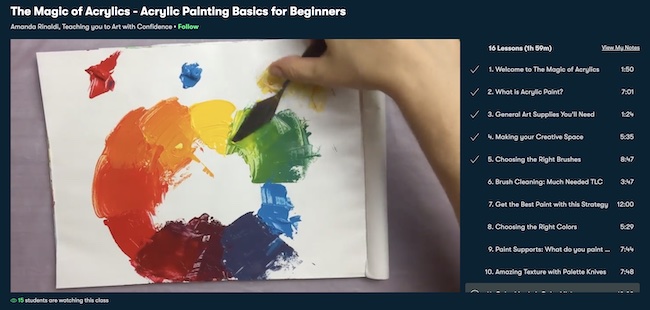
How to Easily Thin Out Thick Acrylic Paint
- 11 Best Palettes for Acrylic Paint (That’ll Elevate Your Painting Experience)
- 12 Perfect Gift Ideas for Artists Who Paint [That’ll Get Their Creative Juices Flowing]
- 20 Easy Christmas Canvas Painting Ideas You’ll Absolutely Love
Pin it for later! ⤵
